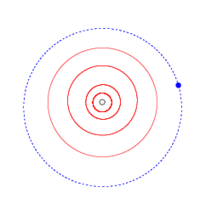(15760) 1992 QB1
|
Orbit of the four outer planets (red) compared to (15760) 1992 QB1 (blue). | |
| Discovery[1] | |
|---|---|
| Discovered by |
David C. Jewitt, Jane X. Luu |
| Discovery site | Mauna Kea Obs. |
| Discovery date | 30 August 1992 |
| Designations | |
|
Trans-Neptunian object (cubewano)[2] | |
| Orbital characteristics[3] | |
| Epoch 13 January 2016 (JD 2457400.5)[3] | |
| Uncertainty parameter 3 | |
| Observation arc | 7707 days (21.10 yr) |
| Aphelion | 46.6644 AU (6.98089 Tm) |
| Perihelion | 40.8952 AU (6.11783 Tm) |
| 43.7798 AU (6.54936 Tm) | |
| Eccentricity | 0.065888 |
| 289.68 yr (105806 d) | |
Average orbital speed | 4.4961 km/s |
| 26.9869° | |
| 0° 0m 12.249s / day | |
| Inclination | 2.19059° |
| 359.4924° | |
| 2.73215° | |
| Earth MOID | 39.891 AU (5.9676 Tm) |
| Jupiter MOID | 35.9341 AU (5.37566 Tm) |
| Physical characteristics | |
| Dimensions |
167 km[4] 108 km[5] |
| 0.2 (expected from theory)[5] | |
| ~23.4[6] | |
| 7.1[3] | |
|
| |
(15760) 1992 QB1 was the first trans-Neptunian object to be discovered after Pluto and Charon. It was discovered in 1992 by David C. Jewitt and Jane X. Luu at the Mauna Kea Observatory, Hawaii. It is a classical Kuiper belt object and gave rise to the name cubewano for this kind of object, after the "QB1" portion of its designation.[7] Decoding its provisional designation, "QB1" reveals that it was the 27th object found in the second half of August of that year. Over 1,500 further objects have been found beyond Neptune, a good number of which are classical Kuiper belt objects.
The discoverers suggested the name "Smiley" for (15760) 1992 QB1,[8] but the name was already used for an asteroid 1613 Smiley, named after the American astronomer Charles Hugh Smiley. It has received the number 15760[2] and remains unnamed; it is normally referred to simply as "QB1", even though this is technically ambiguous without the year of discovery.
Notes
^ Asteroid provisional designations follow a format, in which the year it was discovered comes first, followed by the half-month it was discovered alphabetically (e.g. A=January 1–15, B=January 16–31 and so on,) and then the order of its discovery alphabetically (skipping the letter I) followed by a number (e.g. 1992 QA, 1992 QB, 1992 QC ... 1992 QY, 1992 QZ, 1992 QA1, 1992 QB1 and so on.) According to this, Q=August 16–31 and B1=25+2=27.
References
- ↑ "IAUC 5611: 1992 QB1". IAU Minor Planet Center. 14 September 1992. Retrieved 2011-07-05.
- 1 2 Marc W. Buie (30 November 1999). "Orbit Fit and Astrometric record for 15760". SwRI, Space Science Department. Retrieved 2008-09-28.
- 1 2 3 "JPL Small-Body Database Browser". Jet Propulsion Laboratory. Retrieved 5 April 2016.
- ↑ William Robert Johnston (28 December 2015). "List of Known Trans-Neptunian Objects". Johnston's Archive. Retrieved 2015-01-03.
- 1 2 Mike Brown, 'How many dwarf planets are there in the outer solar system? Archived October 18, 2011, at the Wayback Machine. Accessed 2014-11-19
- ↑ "AstDys (15760) 1992QB1 Ephemerides". Department of Mathematics, University of Pisa, Italy. Retrieved 2010-03-03.
- ↑ Dr. David Jewitt. "Classical Kuiper Belt Objects". David Jewitt/UCLA. Archived from the original on 2013-07-05. Retrieved July 1, 2013.
- ↑ What Lurks in the Outer Solar System? (Science@NASA, 13 September 2001)
External links
- Orbital simulation from JPL at Nasa(Java)
- Ephemeris
- (15760) 1992 QB1 at the JPL Small-Body Database

